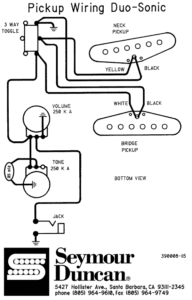The Fender Duosonic and MusicMaster.
Collectibility Rating: 1956-1959 DuoSonic: D-, 1959-1965 DuoSonic: D–. The single pickup MusicMaster is considered a “F” for all years.
1959 DuoSonic.

-
- First introduced in mid 1956, the original Duosonic (two pickups) and the Musicmaster (one pickup) were Fender’s 3/4 size, student model, 22.5″ short scale beginners guitars. Master tone, master volume, 3-way pickup selector (switch on Duosonic only; with the switch in the middle position, the two pickups are in series, giving a humbucking pickup type sound). Hence their value is low compared to other models. These short scale student models were made to the same high quality standards and materials that Fender used for its more expensive models. For this reason, pre-1964 Musicmasters and Duo-Sonics are very well made.
In late 1964 both models moved to second generation, coinciding with the introduction of the Mustang. The “II” designation was then added to the DuoSonic and MusicMaster names. These models are more like the Mustang (except the Mustang has a vibrato), than the original DuoSonic/MusicMaster models. The differences in the new generation were in the body shape, pickguard, and electronics. It was available with either a 22.5″ or 24″ scale, but is most often found with the longer scale. The 24″ scale Duo-Sonic II, Musicmaster II, and Mustang of the September 1965 to October 1966 period are sometimes found with a slab rosewood fingerboard, usually of Indian rosewood (click here for a picture of this). Some Fender experts speculate that the slab board necks were leftovers from 1962 Jaguars. This is not correct as the dot spacing, peghead shape, and type of rosewood on a 1962 jaguar neck is different than these 9/65 to 10/66 necks. Mostly likely, since Fender was backordered on these guitars, slab boards were used because the manufacturing process was quicker for this style of fingerboard (a veneer fingerboard requires another manufacturing step).
-
- 1956 Duosonic/Musicmaster specs:
-
- Slab 3/4 size body, Desert Sand brown finish. Early 1956 models had an Ash body, later 1956 models had an Alder body.
- Anodized aluminum pickguard (Duosonic has two pickups, Musicmaster has one pickup).
- Serial number on neck plate.
- One piece maple 22.5″ short-scale neck, 1 5/8″ nut width.
-
1959 Duosonic/Musicmaster specs:
-
- Sunburst finish offered. This sunburst if often called “maroonburst” since it is an opaque finish with a yellow or peach center, and maroonish edges. Sometimes this sunburst was painted over the Desert Sand color.
- Slab Rosewood fingerboard.
- Single layer thick white pickguard.
-
- Mid-1961 Duosonic/Musicmaster specs:
-
- Desert Sand color dropped; only available in sunburst.
- 1.5″ nut width.
-
1963 Duosonic/Musicmaster specs:
-
-
- Sunburst finish dropped, white finish now standard. During late summer/fall of 1963 brown plastic pickguards are seen on these models with white body finish.
-
Late 1964 Duosonic II/Musicmaster II specs:
-
-
- Scale length increased to 24″.
- “II” added after model name to designate increased scale length.
- Body restyled like Mustang with offset waist.
- 3 ply plastic pickguard.
- Colors available were red, white and blue.
-
1969 DuoSonic discontinued.
1969 Musicmaster: both 22 1/2″ and 24″ scale models designated “Musicmaster”
1982 Musicmaster discontinued.
The Fender Mustang.
Collectibility Rating: D- (due to it’s short scale and student model designation).
1969 “Competition” Mustang
with white “racing strip”

-
- The Fender Mustang was introduced in August 1964 before the sale of Fender Electric Instruments to CBS. The idea was to create a mid-line model between the student grade DuoSonic, and the professional Telecaster. The Mustang was a very popular model, and was made until 1981. Originally designed with a 22.5″ inch scale guitar, the Mustang is almost always found with a 24 inch scale. Early models had a slab alder body, but it was given the patented Fender contour body in early 1969.
The Mustang had two pickups and (usually) a 24″ short scale length. Though the scale length is longer than the original Duosonics/Musicmasters (which had 22.5″ scales), the Mustang is still considered a “student model”. Hence their value is low compared to other models. Originally the Mustang was introduced to replace the entire DuoSonic/MusicMaster line, becoming the new Fender student model. But The introduction of the Mustang moved the DuoSonic/MusicMaster lines to a second generation, 24″ scale length. Due to extreme backorders, all student-line Fenders stayed intact to 1969 when demand dropped and the DuoSonic was discontinued.
August 1964 Mustang specs:
-
-
- Slab body, red or white or blue finish.
- Gold “transitional” peghead logo.
- 2 slant mounted pickups with plastic covers and no visible poles.
- 2 on/off switches.
- Master volume and tone.
- Tremolo.
-
1968 Mustang specs:
-
- Black Fender decal.
- “F” style tuning gears replaces Kluson gears.
- Polyester thick finish replaces nitrocellulose lacquer.
-
- 1969 “Competition” Mustang specs:
-
- Red, blue, burgundy or orange finish with a white racing stripe.
- Contour body.
-
Mustang discontinued 1982.

